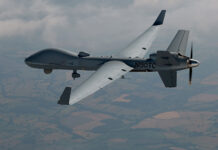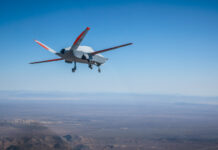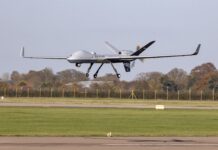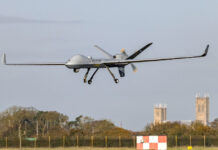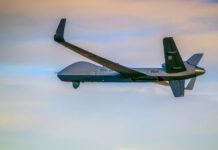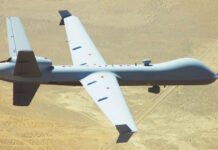Dozens of new strike unmanned aerial vehicles (UAVs) are entering service globally, displaying a wide variety of sizes, configurations, and capability profiles. The widespread use of strike drones has highlighted their cost-effectiveness and adaptability, making them an important component of strike capability for modern militaries.
The first strike drones – unmanned aircraft designed to deliver ordnance and return safely – emerged in the early 2000s. Most recently, strike UAVs have played a transformative role in the Second Nagorno-Karabakh War of 2020, showcasing their potential. However, by contrast their impact in the War in Ukraine was considerably lower. While Ukraine’s strike UAVs did see some initial success, they nonetheless rapidly encountering limitations operating against modern air defence systems. Consequently, their role in that conflict has been greatly overshadowed by small UAVs, which have been employed at massive scales.
Today, strike drones come in various configurations, displaying diverse size, speed, range, payload, propulsion system and launch technique. In addition to weapons, they also carry sensor payloads, both to aid in target acquisition and destruction, and to provide a second mission capability as reconnaissance assets. Each combination of attributes has unique capabilities optimising them for different operational scenarios. Large, long-range drones can mount formidable arsenals of standoff weapons and loiter over the target zone to detect targets of opportunity. However, they are more vulnerable to detection by enemy air defence systems, and less attritable than their smaller counterparts. Globally, dozens of new strike UAVs have either entered service recently or are currently in development. This article will introduce a representative selection, including a wide variety of designs.
Europe
Jackal (UK)
The Jackal vertical take-off and landing (VTOL) drone was developed by British firm Flyby Technology and Türkiye’s Fly BVLOS Technology. It is currently being used as a technology demonstrator with the intention of informing future development of a UAV family.
![The Flyby Jackal launches an LMM during testing. [Crown Copyright 2023]](https://euro-sd.com/wp-content/uploads/2025/07/Jackal_Crown-Copyright-Kopie-1024x575.jpg)
The Flyby Jackal launches an LMM during testing. [Crown Copyright 2023]
The demonstrator aircraft’s propulsion is provided through four pairs of contra-rotating propellers for vertical flight, and four wing-mounted electric ducted fan (EDF) engines for high-speed horizontal flight (graphics on the Flyby Technology website also show an alternate configuration with six EDFs). The VTOL technology enables deployment from confined spaces without runways, including urban and forest settings and from ships. The modular plug and play design is expected to facilitate development of an operational future RPAS family capable of delivering flexible combat capability to UK and allied armed forces.
Hitbird (Germany)
The B&S Tech on Target GmbH based in Neustadt, Germany produces the Hitbird drone family, marketing it as suitable for mass production at scale. B&S Tech on Target introduced the Hitbird family at Eurosatory 2024.
The Hitbird flying wing drones feature an all-metal construction using aircraft-grade aluminium, for a robust airframe. Skin and airframe elements can be readily exchanged, allowing quick turnaround of damaged UAVs. All Hitbirds are powered by a single two-stroke piston engine (between 5 hp and 60 hp) driving a nose-mounted propeller.
The drones are produced in three size categories, designated according to their wingspan measurements:
- Hitbird 175: Wingspan 175 cm, dry weight 6 kg, payload up to 5.5 kg;
- Hitbird 350: Wingspan 350 cm, dry weight 20 kg, payload up to 29 kg;
- Hitbird 700: Wingspan 700 cm, dry weight 60 kg, payload up to 70 kg.
Weapons can be carried internally or on underwing hardpoints. Payload options include sensors for ISR or (if fitted with munitions) targeting sensors (for onboard munitions), and munitions on underwing hardpoints. Maximum speed of all variants is around 200 km/h. Range varies depending on payload and amount of fuel, with the user required to lose some available payload to attain maximum range. As notional figures the manufacturer claims a 1,000 km range for Hitbird 175 with 3.5 kg of fuel, or 840 km for Hitbird 350 with 17 kg of fuel, or 1,680 km for Hitbird 700 with 60 kg of fuel.
Middle East
Israel: Golden Eagle Heavy Strike
The Golden Eagle Heavy Strike drone is manufactured by Israeli firm Steadicopter is a rotary-wing type UAV first displayed at the AUSA 2024 exhibition. It has a maximum take-off weight (MTOW) of 50 kg and a payload of up to 15 kg. It can also be deployed by frontline ground forces and special operations forces for reconnaissance and precision strike missions.
Payload options include the Rafael Spike SR and LR2 missiles, allowing the UAV to execute precision strikes against armoured vehicles, soft and hardened structures, and maritime targets. Each UAV carries a single missile beneath the hull. Operational scenarios include armed reconnaissance, close-air-support, border protection, perimeter security, and urban warfare. The rotary configuration allows it to take off from confined spaces. Endurance is given as “less than one hour”, while operating range is up to 50 km line of sight (LoS) from the ground control station.
![The Golden Eagle rotary strike UAV mounting a Rafael Spike family missile. [Steadicopter]](https://euro-sd.com/wp-content/uploads/2025/07/Golden-Eagle-HS-1-Kopie-1024x576.jpg)
The Golden Eagle rotary strike UAV mounting a Rafael Spike family missile. [Steadicopter]
Adasi Reach-M
UAE-based EDGE Group introduced the Adasi Reach-M at the November 2023 Dubai air show. This UAV has a 24-hour endurance and is optimised for prolonged armed ISR and precision ground attack missions. The 8.7 m long aircraft has a 17 m wingspan and an MTOW of 1,500 kg. The payload capacity of 350 kg permits carriage of precision-guided munitions (PGMs) and loitering munitions on seven hardpoints.
The known payload selection includes the RASH-3 guided glide bomb (33 kg class) and the Desert Sting-25 guided glide bomb (47 kg class; 25 kg warhead). The Reach M utilises a three-blade pusher propeller, with an intake positioned on top of the rear fuselage to provide airflow and cooling for the engine. The Reach M has a cruising speed of 175 km/h and a service ceiling of 8,000 m. The UAV utilises secure communication links to receive real-time targeting and mission updates from the ground control station.
Türkiye
Bayraktar Kizilelma
The Turkish Baykar Technologies’ Bayraktar Kızılelma (UAV) is specifically designed for carrier-based operations including anti-surface warfare and land-attack missions, as well as air-to-air combat. The Turkish armed forces plan to deploy the UAV on the TCG Anadolu amphibious assault ship/light aircraft carrier. It can also operate from short runways on land. Missions are be controlled from a ground station, however the Kizilelma is envisioned as being capable of carrying out many tasks autonomously, including carrier take-off and landing as well as air-to-air engagements.
The drone measures 14.5 m long, with a 10 m wingspan. With its sleek fuselage, swept wings, nose-mounted canards and twin-tail design, the jet-powered Kizilelma closely resembles a low-observable manned fighter aircraft. It is designed to be highly manoeuvrable while maintaining a low radar signature.
![The production prototype during medium-altitude system identification testing in March 2023. [Baykar Technologies]](https://euro-sd.com/wp-content/uploads/2025/07/Bayraktar-Kizilelma-Kopie-1024x683.jpg)
Baykar plans to develop three variants of the Kizilelma. The initial ‘A’ variant will achieve a cruise speed of Mach 0.6 and a sprint speed of Mach 0.9, with a service ceiling of 13,850 m and a standard operating altitude of 7,700 m. Baykar promises more than three hours of mission endurance. The ‘B’ and ‘C’ variants will achieve transonic (typically around Mach 0.8 to 0.99) and supersonic speeds (>Mach 1), respectively. The ‘A’ and ‘B’ variants will be powered by a single afterburner-capable turbofan engine. The ‘C’ variant will be configured with two engines. The ‘A’ variant undertook its maiden flight on 14 December 2022, completing its 12th flight test on 17 June 2023, and according to an October 2024 statement by Baykar Technologies Chairman and Chief Technology Officer (CTO) Selçuk Bayraktar, the vehicle is now in production, with a batch of “more than 10” slated to be ready in 2026.
United States
GA-ASI Gray Eagle STOL/Mojave
The General Atomics Aeronautical Systems, Inc. (GA-ASI) Gray Eagle STOL (also known by its demonstrator name ‘Mojave’) is a descendent of the MQ-1C Gray Eagle medium-altitude, long-endurance (MALE) design, optimised for short take-off and landing (STOL) and ruggedised for operation in austere environments. Compared to its predecessors, the Mojave features a more robust landing gear, and redesigned wings and control surfaces, enabling it to operate from aircraft carriers, roadways, and unimproved dirt or grass strips and beaches.
With an MTOW of 3,175 kg, the Gray Eagle STOL has a high payload capacity, fitted with seven hardpoints capable of accepting a combined 1,540 kg of useful load. As a representative example, the UAV is capable of accommodating 16 AGM-114 Hellfire family missiles (eight per wing). Various other PGMs can be used instead, potentially including the AGM-179 joint air-to-ground missile (JAGM). In 2024, a ‘Mojave’ test aircraft mounting two Dillon Aero DAP-6 gun pods, each with a six-barrel M134D-H gatling gun, demonstrated the capability to conduct strafing attacks.
![The Gray Eagle STOL strike UAV can carry a payload of 16 Hellfire missiles. [GA-ASI]](https://euro-sd.com/wp-content/uploads/2025/07/Mojave-Kopie-1024x577.jpg)
Jump 20-X Maritime VTOL
Aerovironment’s Jump 20-X drone is also designed for maritime and expeditionary operations, but its VTOL configuration makes it suitable for vessels with limited deck space. Aerovironment explains that the ‘X’ in the name represents “cross-domain dominance” and denotes the advanced Group 3 UAV’s suitability for operating over both land and sea. Equipped with AI-enabled automation software, the drone can reportedly complete a major portion of its missions without crew intervention.
The compact UAV (2.9 m in length, with a 5.7 m wingspan) has an MTOW of 97.5 kg and a payload capacity of 13.6 kg. In addition to sensors and communication systems, the drone can mount small precision-guided munitions, including the Northrop Grumman Hatchet and Corvid Technologies/L3Harris Shryke. Four vertical lift two-blade rotors facilitate VTOL and hover functions, while a nose-mounted puller prop provides power for vertical flight. The bow-mounted two-stroke engine can utilise JP-5, JP-8, Jet-A and MoGas, enhancing operational flexibility, especially under expeditionary conditions. The engine achieves speeds of 93 km/h (50 kn) and allows for 13 hours of endurance. The maximum range possible for the radio command link is 185 km.
The 20-X is a navalised derivative of the original Jump 20 UAV which is already operational with the US and Danish armed forces. Aerovironment displayed the 20-X at the IDEX 2025 exhibition. At that time Charles Dean, corporate vice president of international business, said that the drone was in the final testing phase, with sales beginning “in the next few months.”
Mayman Razor
California-based Mayman Aerospace is developing the Razor family of high-speed VTOL UAVs. The modular drones can be deployed for ISR, electronic warfare, target designation, logistics or even strike missions. According to Mayman, this family of drones will include AI-enabled automation software for navigation and control.
The firm plans to present the Razor in three size classes, beginning with the P100 (45 kg payload), followed by the P500 (227 kg payload) and P1000 (450 kg payload). The two larger variants are due to be configured to carry guided missiles in the Hellfire or Brimstone size class, as well as air-to-air missiles. Each drone is equipped with four jet engines positioned at the four corners of the aircraft. The engine nacelles cant vertically for take-off, landing and hover, then reposition horizontally for high speed level flight. According to the manufacturer, the engines can operate on any heavy fuel. Performance parameters of the Razor family include speeds up to 800 km/h, and a ceiling up to circa 6,100 m. The smallest variant will be able to launch from a 3×3 m area.
Company founder and CEO David Mayman highlights the UAVs as “cost effective, quick to manufacture, relatively expendable and [deployable] in sufficient numbers to meet future battlefield requirements. One of the first casualties of modern warfare will be airfields, and therefore VTOL aircraft will be critical to future conflict success.”
![Concept image of Razor VTOL drones on an attack mission. [Mayman Aerospace]](https://euro-sd.com/wp-content/uploads/2025/07/Razor-VTOL-Kopie-1024x683.jpg)
Hypersonic strike UAV concepts
Technological development breeds constantly greater expectations. In February 2025, the Pentagon’s Defense Advanced Research Projects Agency (DARPA) issued a broad agency announcement concerning interest in Next Generation Responsive Strike (Next RS) air platforms. The agency’s Aerospace Projects Office (APO) is “working in close partnership with Air Force Research Laboratory (AFRL) and [NASA]” to advance this project, which seeks to develop a stealthy, highly agile hypersonic bomber capable of conducting rapid strike missions. The government hopes to finalise designs by the late 2020s and begin prototype flight testing by the early 2030s. The announcement did not specify a preference for either manned or unmanned aircraft. However, numerous aspects of such a project – including potential weight and aerodynamic design advantages of a UAV, the potential physical effect of hypersonic speed combat manoeuvring on a human crew, and the anticipated high risk of deep strike missions – would speak in favour of an unmanned design. Whether through Next RS or not, reusable hypersonic strike UAVs are likely to be on the horizon.
Sidney E. Dean

![The Flyby Jackal launches an LMM during testing. [Crown Copyright 2023]](https://euro-sd.com/wp-content/uploads/2025/07/Jackal_Crown-Copyright-Kopie.jpg)

